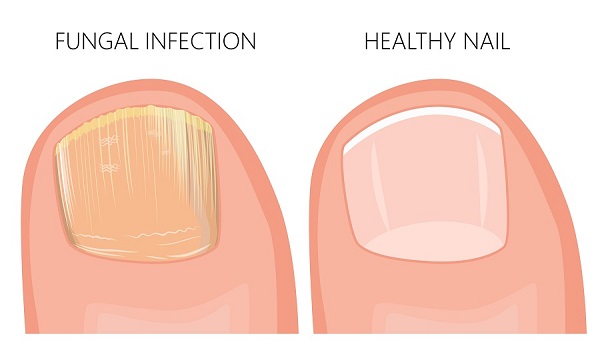


A common nail infection is fingernail and toenail fungus. Under the tip of your fingernail or toenail, it starts as a white or yellow-brown patch. Onychomycosis, another name for fungal nail infections, is a highly prevalent condition. Getting a fungal nail infection is simple. The fungus can spread to one or more of your nails if you have a fungal infection on your foot. Fungi between your toenail and the bed of your toenail cause toenail fungus. Your toenails get infected by toenail fungus, a common fungus. Fingernails may occasionally become infected with nail fungus.
An overabundance of fungus in, under, or on the nail can result in a fungal nail infection.
The majority of fungus nail infections are not dangerous. However, some people could feel pain or worry about how their nails look. Due to fungus, the nail shows thick, brittle, or cracked. Another possibility is for the nail to detach from the nail bed. A severe case of fingernail and toenail fungus can be uncomfortable and potentially harm your nails permanently.
A severe case of fingernail and toenail fungus can be uncomfortable and potentially harm your nails forever. Additionally, if you have an immune system that is reduced as a result of medicine, diabetes, or another disease, it could result in other severe infections that travel beyond your feet. A foot fungal infection can healed within three months of treatment. If you have a severe infection, surgery to permanently remove the nail and its root is the best but least used alternative.
No, nail fungus or illness is not inherited. Like other organisms, fungus is a living thing that needs specific environmental factors to survive. An infection cannot arise spontaneously from genes alone. The unfortunate people who do carry these genes, however, are less able to fight off the infection that results in onychomycosis because their bodies’ immune systems are more susceptible to the toenail fungus that causes it.
The Australian tea tree’s leaves are steamed to produce the essential oil known as tea tree oil. Tea tree oil is thought to be antibacterial when used topically. Tea tree oil is good for acne, athlete’s foot, lice, fingernail and toenail fungus and insect bites. It may also be beneficial against toenail fungus. Twice daily, apply tea tree oil with a cotton swab straight to the damaged nail.
The extract is called oregano oil, and while being less potent than the essential oil, it seems to have health benefits whether applied topically or eaten. It can also be condensed into an essential oil that is rich in potent chemicals with established health advantages. An efficient natural antibacterial and antifungal agent is oregano oil. Utilizing a cotton swab, apply oregano oil twice day to the afflicted nail.
Daily intake of olive oil can lower blood cholesterol, and when applied topically to the skin, it effectively hydrates the skin. Additionally, it is utilized in lip balm, shampoo, and the treatment of various skin conditions.
Extra-virgin pure olive oil is infused with a significant amount of ozone to create Ozonated olive oil. Olive oil’s hydrating and emollient qualities are combined with ozone’s numerous therapeutic benefits. As Ozonated oil speeds up wound healing, it may be used as a treatment for tissue repair.
There are three main types of fingernail and toenail fungus:
The most prevalent type of fungal nail infection, known as distal subungual infections, can affect both fingernails and toenails. When infected, the nail’s outer edge appears ragged and has white or yellow streaks running through it. Toenails, fingernails, or both may become infected with distal subungual onychomycosis. Trichophyton rubrum, which enters the nail bed and the bottom of the nail plate starting at the hyponychium and moving proximally via the underlying nail matrix which is typically the culprit behind the infection.
Certain fungi that directly infect the nail plate’s superficial layers and leave behind clearly defined opaque “white islands” on the plate are the root cause of white superficial onychomycosis. These spots combine to affect the entire nail plate as the condition worsens. The nail becomes brittle, crumbly, and rough.
Candida yeast is the causes of this infection. It can enter nails that have already suffered damage from an infection or accident. Candida more frequently damages fingernails. People who routinely soak their hands in water are more likely to experience it. These infections typically begin at the cuticle, which is painful to the touch, swollen, red, and surrounding the nail. The actual nail may partially lift off the nail bed or completely fall off.
Chicken Pox Blisters: Major Signs, Causes & Risk Elements
7 Major Causes, Symptoms & Types Of Melasma On Face
5 Common Teeth Problems And How To Avoid It